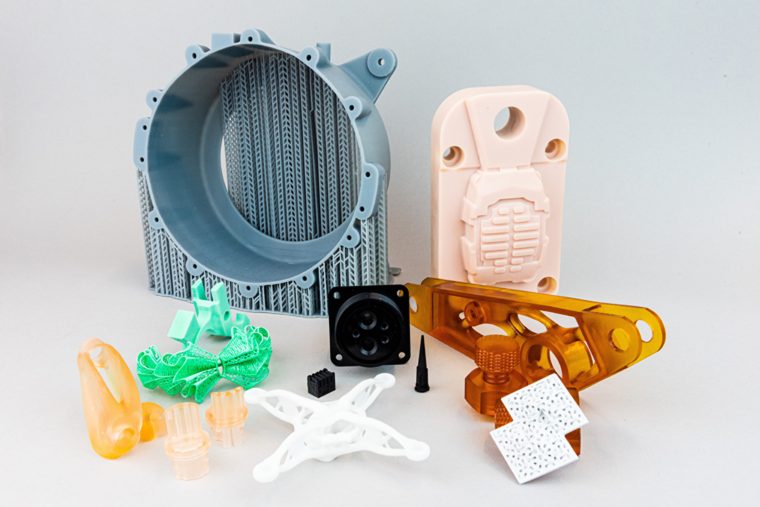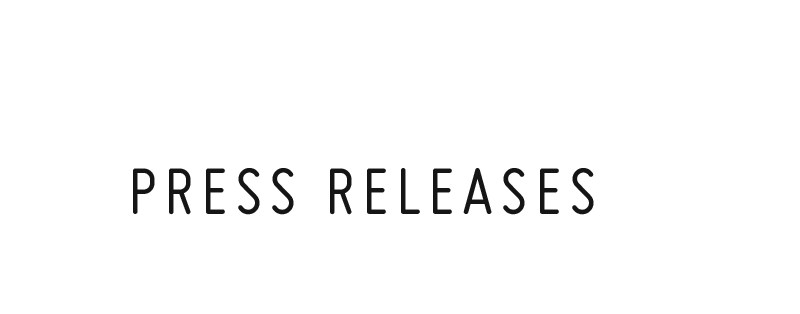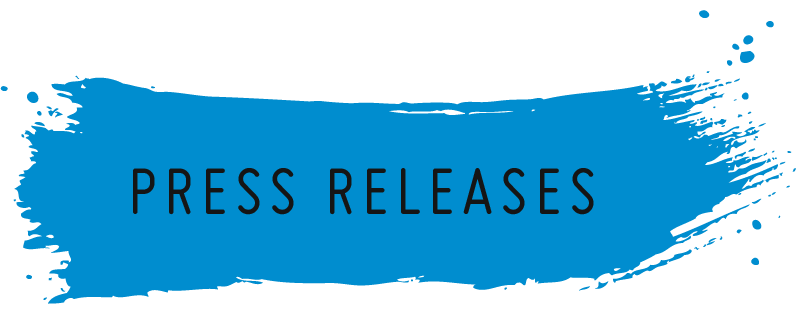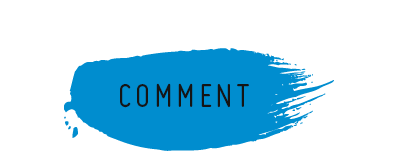- 3D Print Bureau
- 6K
- Agmatix
- Airwayz
- AM-Flow
- Appadda
- Caracol
- CG Trader
- CyberOptics
- e-Xstream
- GenCell
- GreenEye
- Impossible Objects
- Incus Media
- InkBit
- ITG
- JPB Systeme
- KeyProd
- Landa
- LEO Lane
- Lumet
- Magic Software
- MakerBot
- Marketiger
- Nano Dimension
- Paragon Rapid Technologies
- PearlX
- Plant & Bean
- Redefine Meat
- Replique
- Ripples
- Sakuu Corporation
- SolarEdge
- StoreDot
- Stratasys
- Sunrock
- The Bespoke Group
- Trigo
- UltiMaker
- Xjet
STRATASYS EXPANDS MATERIALS ECOSYSTEM WITH 16 NEW MATERIALS ACROSS THREE ADDITIVE MANUFACTURING TECHNOLOGIES
First Validated materials for FDM 3D printers announced
P3 adds open, exploratory materials for Origin One 3D printer
SAF-powered H350 3D printer to support polypropylene and PA12 powder
EDEN PRAIRIE, Minn. & REHOVOT, Israel, May 10, 2022 – Stratasys Ltd. (NASDAQ: SSYS), a leader in polymer 3D printing solutions, today announced new manufacturing materials across three different 3D printing technologies, including third-party materials for FDM® 3D printers for the first time. The addition of 16 new materials dramatically expands the use cases addressable by Stratasys for a wide variety of manufacturing settings.
Stratasys has rapidly expanded its materials ecosystem to meet the growing demand for additive manufacturing solutions. The new materials include Stratasys Validated materials for FDM 3D printers, a variety of open, exploratory materials for the P3™-based Origin® One 3D printer that can be used with an Open Material License, and polypropylene powder for the SAF™ technology-powered H350™ 3D printer.
Stratasys CEO Dr. Yoav Zeif said the expanded material options open up more compelling additive manufacturing use cases for Stratasys customers. “When customers identify opportunities for how polymer 3D printing can transform their manufacturing, we want them to have the confidence that Stratasys has the solutions – that’s what leaders do,” he said. “With five 3D printing technologies that address the vast majority of the industrial polymer market and an open software ecosystem across the entire digital thread, our growing material ecosystem means customers are getting more materials faster, allowing them to quickly turn their additive manufacturing ideas into reality.”
First Validated Third-Party FDM Materials
Stratasys is partnering with materials providers Covestro, Kimya, and Victrex plc to make Stratasys Validated materials available for Stratasys FDM printers, starting with the Fortus® 450mc platform. These materials have been validated by Stratasys with basic reliability testing to accelerate the expansion of material options available in the marketplace. New FDM materials include:
- High performance polymers: Arkema/Kimya PEKK-SC, a semi-crystalline PEKK thermoplastic polymer based on KEPSTAN® by Arkema; and VICTREX AM™ 200, a semi-crystalline LMPAEK™ thermoplastic filament compatible with soluble support.
- Reinforced and specialty polymers: Covestro PA6/66 GF20 FR, a flame-resistant, glass fiber composite material.
- Engineering polymers: Kimya PC FR, a flame-resistant polycarbonate material.
- Standard Grade Polymer: HIPS high impact polystyrene
The Validated third-party materials are expected to ship before the end of the year.
Stratasys has also introduced a new material at the highest-performance Stratasys Preferred tier. FDM Nylon-CF10 is a strong, carbon fiber composite material that is expected to be available by the middle of the year.
New Open Exploratory Materials for Origin One
Stratasys also continues to expand the use cases served by the Origin One 3D printer by giving customers access to novel materials through an annual Open Material License (OML), which Stratasys introduced last fall. Stratasys has identified eight new materials for the OML program that unlock end-use applications with demanding requirements.
Materials developers contributing new Open materials to the program include Covestro, Evonik, Arkema, Forward AM from BASF, Mechnano, Tethon 3D, Liqcreate, and polySpectra. The materials include photopolymer resins for molding, casting, high-temperature, ceramic, electrostatics dissipative (ESD), and elastic applications. The materials can be purchased directly from material partners or their distributors and are designed for advanced users for testing, development, and end-use parts with exotic or novel properties.
H350 to Add Polypropylene
Additionally, Stratasys announced that polypropylene (PP) material for the H350™ 3D printer powered by SAF™ technology, which is designed for volume production of 3D-printed parts. Polypropylene is a versatile, flexible and extremely popular polymer. Its higher ductility and chemical resistance, as well as its ability to be sterilized makes it suitable for a wide variety of applications, such as interior and exterior automotive parts, prosthetics, and consumer goods.
Together with PA12 (also known as Nylon 12), which Stratasys announced in September 2021, polypropylene will expand the material set for the H350 printer from the initial Stratasys High Yield PA11, a sustainable material derived from 100% bio-based castor beans. PA12, the single most popular material in industrial 3D printing today[1], provides geometric accuracy, chemical resistance and stiffness for machine components, communications industry applications, and prototyping. Both PA12 and PP are expected to be available later in 2022.
Stratasys now provides a progressively managed open-material ecosystem for the industry’s most comprehensive polymer additive technologies, delivering the broadest range of optimized and validated materials. Through GrabCAD Print™ software, customers will now have access to system print parameters to refine material capabilities as needed, optimizing part performance.
All Stratasys Preferred materials and Validated materials for Stratasys systems are available for purchase through Stratasys and reseller partner channels.
A live event, with replay available, will provide more information on new manufacturing solutions from Stratasys on Wednesday, May 11.
[1] “Additive Manufacturing Market Report,” AMPOWER, March 2022
-
 Stratasys has introduced new manufacturing materials across three different 3D printing technologies, including third-party materials for FDM® 3D printers for the first time
Stratasys has introduced new manufacturing materials across three different 3D printing technologies, including third-party materials for FDM® 3D printers for the first time
Click here to download 300dpi images
STRATASYS ÉTEND SON ÉCOSYSTÈME DE MATÉRIAUX AVEC 16 NOUVEAUX MATÉRIAUX POUR TROIS TECHNOLOGIES DE FABRICATION ADDITIVE
Annonce des premiers matériaux validés pour les imprimantes 3D FDM
P3 ajoute des matériaux ouverts et exploratoires pour l’imprimante 3D Origin One
Imprimante 3D H350 optimisée par la technologie SAF pour prendre en charge le polypropylène et la poudre PA12
EDEN PRAIRIE, Minn. et REHOVOT, Israël, 11 mai 2022 – Stratasys Ltd. (NASDAQ : SSYS), l’un des principaux fournisseurs de solutions d’impression 3D en polymère, a annoncé aujourd’hui de nouveaux matériaux de fabrication pour trois technologies d’impression 3D différentes, y compris, pour la première fois, des matériaux tiers pour les imprimantes 3D FDM®. L’ajout de 16 nouveaux matériaux élargit considérablement les cas d’utilisation que Stratasys peut prendre en charge pour une grande variété de paramètres de fabrication.
Stratasys a rapidement étendu son écosystème de matériaux pour répondre à la demande croissante de solutions de fabrication additive. Parmi les nouveaux matériaux figurent ceux validés par Stratasys pour les imprimantes 3D FDM, une variété de matériaux ouverts et exploratoires pour l’imprimante 3D Origin® basée sur la technologie P3™, qui peuvent être utilisés avec une licence matériaux ouverte et de la poudre de polypropylène pour l’imprimante 3D H350™ optimisée par la technologie SAF™.
Yoav Zeif, PDG de Stratasys, a déclaré que l’élargissement des options de matériaux ouvrait la voie à des cas d’utilisation de fabrication additive plus attrayants pour les clients de Stratasys. « Lorsque les clients identifient des possibilités de transformer leur fabrication grâce à l’impression 3D polymère, nous voulons qu’ils aient la certitude que Stratasys a les solutions qu’il leur faut. C’est ce que font les leaders », a-t-il déclaré. « Avec cinq technologies d’impression 3D qui répondent aux principaux besoins du marché des polymères industriels et un écosystème logiciel ouvert qui couvre l’ensemble du fil numérique, notre écosystème de matériaux en pleine expansion permet aux clients d’obtenir plus de matériaux plus rapidement, et donc de concrétiser plus vite leurs idées de fabrication additive. »
Premiers matériaux FDM tiers validés
Stratasys s’associe aux fournisseurs de matériaux Covestro, Kimya et Victrex plc pour mettre les matériaux validés par Stratasys à la disposition des imprimantes FDM de Stratasys, en commençant par la plate-forme Fortus® 450mc. Ces matériaux ont été validés par Stratasys sur la base de tests de fiabilité simples en vue d’accélérer l’expansion des options de matériaux disponibles sur le marché. Les nouveaux matériaux FDM comprennent les suivants :
- Polymères haute performance: Arkema/Kimya PEKK-SC, un polymère thermoplastique PEKK semi-cristallin à base de KEPSTAN® d’Arkema ; et VICTREX AM™ 200, un filament thermoplastique semi-cristallin LMPAEK™ compatible avec un support soluble.
- Polymères renforcés et spéciaux: Covestro PA6/66 GF20 FR, un matériau composite en fibre de verre ignifuge.
- Polymères techniques: Kimya PC FR, un matériau en polycarbonate ignifuge.
- Polymère de qualité standard : polystyrène à fort impact HIPS
Les matériaux tiers validés devraient être livrés avant la fin de l’année.
Stratasys a également présenté un nouveau matériau de niveau Stratasys Preferred, le plus performant. Le Nylon-CF10 FDM est un matériau composite robuste en fibre de carbone qui devrait être disponible d’ici le milieu de l’année.
Nouveaux matériaux exploratoires ouverts pour l’Origin One
Stratasys continue également à élargir les domaines d’utilisation de l’imprimante 3D Origin One en permettant aux clients d’accéder à de nouveaux matériaux à travers une licence annuelle Open Material License (OML), présentée par Stratasys l’automne dernier. Stratasys a identifié huit nouveaux matériaux pour le programme OML, qui débloquent des applications d’utilisation finale aux exigences élevées.
Les concepteurs de matériaux qui contribuent au programme avec de nouveaux matériaux ouverts incluent Covestro, Evonik, Arkema, Forward AM de BASF, Mechnano, Tethon 3D, Liqcreate et polySpectra. Les matériaux comprennent des résines photopolymères pour le moulage, le coulage, les applications à haute température, la céramique, la dissipation électrostatique (ESD) et les applications élastiques. Les matériaux sont vendus directement par les partenaires ou leurs distributeurs et sont destinés aux utilisateurs avancés pour les essais, le développement et les pièces d’utilisation finale présentant des propriétés exotiques ou inédites.
Ajout du polypropylène pour le modèle H350
En outre, Stratasys a annoncé l’ajout du matériau polypropylène (PP) pour l’imprimante 3D H350™ optimisée par la technologie SAF™, conçue pour la production en volume de pièces imprimées en 3D. Le polypropylène est un polymère polyvalent, flexible et extrêmement populaire. Sa ductilité et sa résistance chimique supérieures, ainsi que la possibilité de le stériliser, en font un matériau adapté à une grande variété d’applications, telles que les pièces automobiles intérieures et extérieures, les prothèses et les biens de consommation.
Avec le PA12 (également connu sous le nom de Nylon 12), présenté en septembre 2021 par Stratasys, le polypropylène étendra l’ensemble des matériaux de l’imprimante H350 par rapport au PA11 haute performance initial de Stratasys, un matériau durable dérivé de graines de ricin 100 % biosourcées. Le PA12, le matériau le plus populaire dans le secteur de l’impression 3D industrielle[1], offre une précision géométrique, une résistance chimique et une rigidité pour les composants de machines, les applications de l’industrie des communications et le prototypage. Le PA12 et le PP devraient être disponibles au cours de l’année 2022.
Stratasys fournit désormais un écosystème de matériaux ouverts progressivement géré pour les technologies additives polymères les plus complètes de l’industrie, offrant la plus large gamme de matériaux optimisés et validés. Grâce au logiciel GrabCAD Print™, les clients auront désormais accès aux paramètres d’impression du système pour affiner les capacités en termes de matériaux selon leurs besoins, optimisant ainsi les performances des pièces.
Tous les matériaux Stratasys Preferred et Stratasys Validated destinés aux systèmes Stratasys sont disponibles à l’achat via Stratasys et les canaux de partenaires revendeurs.
Un événement en direct le mercredi 11 mai, disponible en replay, permettra d’en savoir plus sur les nouvelles solutions de fabrication de Stratasys.
[1] « Rapport sur le marché de la fabrication additive », AMPOWER, mars 2022
-
 Stratasys a introduit de nouveaux matériaux de fabrication pour trois technologies d'impression 3D différentes, y compris, pour la première fois, des matériaux tiers pour les imprimantes 3D FDM®
Stratasys a introduit de nouveaux matériaux de fabrication pour trois technologies d'impression 3D différentes, y compris, pour la première fois, des matériaux tiers pour les imprimantes 3D FDM®
Click here to download 300dpi images
STRATASYS ERWEITERT MATERIAL-ÖKOSYSTEM MIT 16 NEUEN MATERIALIEN FÜR DREI ADDITIVE FERTIGUNGSTECHNOLOGIEN
Erste validierte Materialien für FDM 3D-Drucker angekündigt
P3 unterstützt innovative Drittanbieter-Materialien für den 3D-Drucker Origin One
3D-Drucker H350 mit der SAF-Technologie unterstützt Polypropylen- und PA12-Pulver
EDEN PRAIRIE, Minn. & REHOVOT, Israel, 11. Mai 2022 – Stratasys Ltd. (NASDAQ: SSYS), ein führender Anbieter von Polymer-3D-Drucklösungen, hat heute neue Fertigungsmaterialien für drei verschiedene 3D-Drucktechnologien angekündigt, darunter erstmals auch Materialien von Drittanbietern für FDM® 3D-Drucker. Mit der Bereitstellung von 16 neuen Materialien erweitert Stratasys die Anwendungsmöglichkeiten für eine Vielzahl von Fertigungsumgebungen erheblich.
Um der wachsenden Nachfrage nach additiven Fertigungslösungen gerecht zu werden, hat Stratasys sein Material-Ökosystem erneut erweitert. Zu den neuen Materialien gehören von Stratasys validierte Materialien für FDM-3D-Drucker, mehrere innovative Fremdmaterialien für den P3™-basierten 3D-Drucker Origin® One, die mit einer Open Material License verwendet werden können, sowie Polypropylenpulver für den mit der SAF™-Technologie arbeitenden 3D-Drucker H350™.
Stratasys CEO Dr. Yoav Zeif sagte, dass die erweiterten Materialoptionen den Stratasys-Kunden noch mehr überzeugende Anwendungsfälle für die additive Fertigung eröffnen. „Sobald Kunden Möglichkeiten erkennen, wie der Polymer-3D-Druck ihre Fertigung verändern kann, sollen sie darauf vertrauen können, dass Stratasys die entsprechenden Lösungen hat – so müssen führende Unternehmen handeln”, sagte er. „Für unsere fünf 3D-Drucktechnologien, die den Großteil des industriellen Polymermarktes abdecken, sowie für unser offenes Software-Ökosystem, das den gesamten digitalen Workflow umfasst, bedeutet unser wachsendes Material-Ökosystem, dass unsere Kunden mehr Materialien schneller erhalten und so ihre Ideen für die additive Fertigung schnell in die Tat umsetzen können.”
Erste validierte FDM-Materialien von Drittanbietern
Stratasys arbeitet mit den Materialherstellern Covestro, Kimya und Victrex plc zusammen, um von Stratasys validierte Materialien für die FDM-Drucker von Stratasys verfügbar zu machen, beginnend mit der Plattform Fortus® 450mc. Diese Materialien wurden von Stratasys nach grundlegenden Zuverlässigkeitstests validiert, um die Materialoptionen auf dem Markt zu erhöhen. Zu den neuen FDM-Materialien gehören:
- Hochleistungspolymere: Arkema/Kimya PEKK-SC, ein teilkristallines thermoplastisches PEKK-Polymer auf der Basis von KEPSTAN® von Arkema, und VICTREX AM™ 200, ein teilkristallines thermoplastisches LMPAEK™-Filament, das mit löslicher Stützstruktur kompatibel ist.
- Verstärkte Polymere und Spezialpolymere: Covestro PA6/66 GF20 FR, ein schwer entflammbares Glasfaser-Verbundmaterial.
- Technische Polymere: Kimya PC FR, ein schwer entflammbares Polykarbonatmaterial.
- Polymer in Standardqualität: HIPS (High Impact Polystyrene), hochschlagfestes Polystyrol
Die validierten Drittanbieter-Materialien sind voraussichtlich noch vor Ende des Jahres verfügbar.
Stratasys hat außerdem ein neues Material in der leistungsstärksten Stufe Stratasys Preferred eingeführt. FDM Nylon-CF10 ist ein starkes Kohlefaser-Verbundmaterial, das voraussichtlich ab Mitte des Jahres verfügbar ist.
Neue innovative Fremdmaterialien für Origin One
Stratasys erweitert ständig die Einsatzmöglichkeiten des 3D-Druckers Origin One, indem es seinen Kunden über eine Open Material License (OML) Zugang zu neuen Materialien bietet. Die OML wurde im letzten Herbst eingeführt und gilt jeweils für ein Jahr. Stratasys hat acht neue Materialien in die OML aufgenommen, die Endanwendungen mit anspruchsvollen Anforderungen ermöglichen.
Zu den Materialentwicklern, die neue Materialien zum OML-Programm beisteuern, gehören Covestro, Evonik, Arkema, Forward AM von BASF, Mechnano, Tethon 3D, Liqcreate und polySpectra. Zu den Materialien gehören Photopolymerharze für Formungs-, Guss-, Hochtemperatur-, Keramik-, elektrostatisch ableitfähige (ESD) und elastische Anwendungen. Die Materialien können direkt von den Materialpartnern oder deren Händlern erworben werden und sind für erfahrene Anwender bestimmt, die Teile mit ungewöhnlichen bzw. neuartigen Eigenschaften entwickeln, testen oder als Endverbrauchsteile fertigen möchten.
Polypropylen für H350
Zudem hat Stratasys angekündigt, dass Polypropylen (PP) als Material für den 3D-Drucker H350™ mit der SAF™-Technologie verwendet werden kann, der für die Serienproduktion von 3D-gedruckten Teilen konzipiert ist. Polypropylen ist ein vielseitiges, flexibles und äußerst beliebtes Polymer. Aufgrund seiner höheren Duktilität und chemischen Beständigkeit sowie seiner Sterilisierbarkeit eignet es sich für eine Vielzahl von Anwendungen, z. B. für Innen- und Außenteile von Kraftfahrzeugen, Prothesen und Konsumgüter.
Polypropylen wird zukünftig neben PA12 (auch bekannt als Nylon 12), das Stratasys im September 2021 ankündigte, und dem bisherigen Stratasys High Yield PA11, einem nachhaltigen Material, das zu 100 % aus biobasierten Rizinusbohnen gewonnen wird, zur Materialpalette für den H350-Drucker gehören. PA12, das derzeit beliebteste Material im industriellen 3D-Druck, bietet geometrische Genauigkeit[1], chemische Beständigkeit und Steifigkeit für Maschinenkomponenten, Anwendungen in der Kommunikationsbranche und das Prototyping. Sowohl PA12 als auch PP werden voraussichtlich im Laufe des Jahres 2022 verfügbar sein.
Stratasys bietet nun ein progressiv verwaltetes, offenes Material-Ökosystem für die branchenweit umfassendsten additiven Technologien auf Polymerbasis, das die breiteste Palette an optimierten und validierten Materialien bereitstellt. Über die Software GrabCAD Print™ haben Kunden nun Zugriff auf die Druckparameter des Systems, um die Materialeigenschaften nach Bedarf zu verfeinern und die Leistung der Teile zu optimieren.
Alle von Stratasys empfohlenen (Preferred) und validierten (Validated) Materialien für Stratasys-Systeme können von Stratasys und über die Kanäle der Vertriebspartner erworben werden.
Auf einer Live-Veranstaltung am Mittwoch, den 11. Mai, die anschließend als Aufzeichnung abrufbar ist, werden weitere Informationen über neue Fertigungslösungen von Stratasys bekanntgegeben.
[1] „Additive Manufacturing Market Report“, AMPOWER, März 2022
-
 Stratasys hat neue Fertigungsmaterialien für drei verschiedene 3D-Drucktechnologien angekündigt, darunter erstmals auch Materialien von Drittanbietern für FDM® 3D-Drucker
Stratasys hat neue Fertigungsmaterialien für drei verschiedene 3D-Drucktechnologien angekündigt, darunter erstmals auch Materialien von Drittanbietern für FDM® 3D-Drucker
Click here to download 300dpi images
STRATASYS AMPLIA L'ECOSISTEMA DEI MATERIALI CON 16 NUOVI MATERIALI ATTRAVERSO TRE TECNOLOGIE DI FABBRICAZIONE ADDITIVA
Annunciati i primi materiali convalidati per le stampanti 3D FDM
P3 aggiunge materiali esplorativi aperti per la stampante 3D Origin One
Stampante 3D H350 con tecnologia SAF per supportare polvere di polipropilene e polvere PA12
EDEN PRAIRIE, Minn. e REHOVOT (Israele), 11 maggio 2022 – Stratasys Ltd. (NASDAQ: SSYS), leader nelle soluzioni di stampa 3D di polimeri, ha annunciato oggi, per la prima volta, nuovi materiali di produzione in tre diverse tecnologie di stampa 3D, inclusi materiali di terze parti per stampanti 3D FDM®. L’aggiunta di 16 nuovi materiali espande notevolmente i casi d’uso affrontabili da Stratasys, per un’ampia varietà di impostazioni di produzione.
Stratasys ha rapidamente ampliato il proprio ecosistema di materiali per soddisfare la crescente domanda di soluzioni di fabbricazione additiva. I nuovi materiali includono materiali convalidati da Stratasys per stampanti 3D FDM, una varietà di materiali esplorativi aperti per la stampante 3D Origin® One basata su tecnologia P3™ che possono essere utilizzati con una Open Material License e polvere di polipropilene per la stampante 3D H350™ basata su tecnologia SAF™.
Il CEO di Stratasys, dott. Yoav Zeif ha affermato che l’ampliamento delle opzioni di materiali apre casi d’uso di fabbricazione additiva più interessanti per i clienti Stratasys. “Quando i clienti identificano le opportunità su come la stampa 3D con i polimeri può trasformare la loro produzione, vogliamo che confidino nel fatto che Stratasys disponga delle soluzioni: questo è ciò che fanno i leader”. “Con cinque tecnologie di stampa 3D che si rivolgono alla stragrande maggioranza del mercato dei polimeri industriali e un ecosistema software aperto attraverso l’intero thread digitale, il nostro ecosistema di materiali in crescita consente ai clienti di ottenere più materiali più velocemente e di trasformare rapidamente le loro idee di fabbricazione additiva in realtà”.
Primi materiali FDM di terze parti convalidati
Stratasys sta collaborando con i fornitori di materiali Covestro, Kimya e Victrex plc per rendere disponibili i materiali convalidati da Stratasys per le stampanti FDM Stratasys, a partire dalla piattaforma Fortus® 450mc. Tali materiali sono stati convalidati da Stratasys attraverso test di affidabilità di base per accelerare l’ampliamento delle opzioni di materiali disponibili sul mercato. I nuovi materiali FDM includono:
- Polimeri ad alte prestazioni: Arkema/Kimya PEKK-SC, un polimero termoplastico PEKK semicristallino a base di KEPSTAN® di Arkema; e VICTREX AM™ 200, un filamento termoplastico LMPAEK™ semicristallino, compatibile con il supporto solubile.
- Polimeri rinforzati e speciali: Covestro PA6/66 GF20 FR, un materiale composito in fibra di vetro resistente alla fiamma.
- Polimeri tecnici: Kimya PC FR, un materiale in policarbonato resistente alla fiamma.
- Polimero di classe standard: polistirene ad alto impatto HIPS
I materiali di terze parti convalidati dovrebbero essere disponibili per la consegna entro la fine dell’anno.
Stratasys ha anche introdotto un nuovo materiale di livello Stratasys Preferred, caratterizzato da prestazioni elevatissime. FDM Nylon-CF10 è un materiale composito in fibra di carbonio resistente che dovrebbe essere disponibile entro la metà dell’anno.
Nuovi materiali esplorativi aperti per Origin One
Stratasys continua inoltre a espandere i casi d’uso serviti dalla stampante 3D Origin One, offrendo ai clienti l’accesso a nuovi materiali attraverso una Open Material License (OML) annuale, introdotta dall’azienda lo scorso autunno. Stratasys ha identificato otto nuovi materiali per il programma OML che sbloccano applicazioni per uso finale con requisiti stringenti.
Gli sviluppatori di materiali che contribuiscono al programma con nuovi materiali aperti includono Covestro, Evonik, Arkema, Forward AM di BASF, Mechnano, Tethon 3D, Liqcreate e polySpectra. I materiali includono resine fotopolimeriche per stampaggio, colata, applicazioni ad alta temperatura, ceramiche, dissipative elettrostatiche (ESD) ed elastiche. I materiali possono essere acquistati direttamente dai partner di materiali o dai loro distributori e sono progettati per utenti avanzati per test, sviluppo e parti di uso finale con proprietà particolari o nuove.
H350 per l’aggiunta del polipropilene
Stratasys ha anche annunciato il materiale in polipropilene (PP) per la stampante 3D H350™ con tecnologia SAF™, progettata per la produzione in serie di parti stampate in 3D. Il polipropilene è un polimero versatile, flessibile ed estremamente diffuso. La sua maggiore duttilità e resistenza chimica, nonché la capacità di essere sterilizzato, lo rendono adatto per un’ampia varietà di applicazioni, come parti automobilistiche interne ed esterne, protesi e beni di consumo.
Insieme al PA12 (altrimenti noto come Nylon 12), annunciato da Stratasys a settembre 2021, il polipropilene amplierà il set di materiali per la stampante H350 a partire dallo Stratasys High Yield PA11, un materiale sostenibile derivato da semi di ricino 100% biologici. Il PA12, il materiale più diffuso oggi nella stampa 3D industriale[1], fornisce precisione geometrica, resistenza chimica e rigidità per componenti di macchine, applicazioni del settore delle comunicazioni e prototipazione. Sia il PA12 che il PP dovrebbero essere disponibili nel corso del 2022.
Stratasys fornisce ora un ecosistema di materiali aperti gestito in modo progressivo per le tecnologie additive polimeriche più complete del settore, offrendo la più ampia gamma di materiali ottimizzati e convalidati. Attraverso il software GrabCAD Print™, adesso i clienti avranno accesso ai parametri di stampa di sistema per perfezionare le capacità di gestione dei materiali secondo necessità, ottimizzando le prestazioni delle parti.
Tutti i materiali preferiti e convalidati da Stratasys per i suoi sistemi sono disponibili per l’acquisto attraverso Stratasys e i canali dei partner rivenditori.
Un evento dal vivo, con replay disponibile, fornirà ulteriori informazioni sulle nuove soluzioni di fabbricazione di Stratasys mercoledì 11 maggio.
[1] “Rapporto sul mercato della fabbricazione additiva”, AMPOWER, marzo 2022
-
 Stratasys ha introdotto nuovi materiali di produzione in tre diverse tecnologie di stampa 3D, inclusi materiali di terze parti per stampanti 3D FDM®.
Stratasys ha introdotto nuovi materiali di produzione in tre diverse tecnologie di stampa 3D, inclusi materiali di terze parti per stampanti 3D FDM®.
Click here to download 300dpi images
STRATASYS EXPANDE EL ECOSISTEMA DE MATERIALES CON 16 NUEVOS MATERIALES GRACIAS A TRES TECNOLOGÍAS DE FABRICACIÓN ADITIVA
Anuncio de los primeros materiales validados para las impresoras 3D FDM
P3 añade materiales exploratorios abiertos para la impresora 3D Origin One
Impresora 3D H350 con tecnología SAF compatible con polipropileno y polvo PA12
EDEN PRAIRIE, Minn. y REHOVOT, Israel, 11 de mayo de 2022 – Stratasys Ltd. (NASDAQ: SSYS), líder en soluciones de impresión 3D de polímeros, anunció hoy nuevos materiales de fabricación en tres tecnologías de impresión 3D diferentes, incluidos, por primera vez, materiales de terceros para impresoras 3D FDM®. La incorporación de 16 nuevos materiales amplía drásticamente los casos prácticos que puede abordar Stratasys para una extensa variedad de entornos de fabricación.
Con el objetivo de satisfacer la creciente demanda de soluciones de fabricación aditiva, Stratasys ha ampliado rápidamente su ecosistema de materiales. Entre los nuevos materiales, hay materiales validados de Stratasys para impresoras 3D FDM, diferentes materiales exploratorios abiertos para la impresora 3D Origin® One basada en P3™, que se puede usar con una licencia de material abierto y polvo de polipropileno para la impresora 3D H350™ con tecnología SAF™.
Yoav Zeif, director general de Stratasys, explica que las nuevas opciones de materiales permiten más casos prácticos de fabricación aditiva interesantes para los clientes de Stratasys. «Cuando los clientes identifican oportunidades sobre cómo la impresión 3D de polímeros puede transformar su fabricación, queremos que tengan la confianza de que Stratasys tiene las soluciones: eso es lo que te convierte en un líder», afirma. «Con cinco tecnologías de impresión 3D que abordan la gran mayoría del mercado de polímeros industriales y un ecosistema de software abierto en todo el entorno digital, nuestro creciente ecosistema de materiales significa que los clientes obtienen más materiales a mayor velocidad, lo que les permite convertir rápidamente sus ideas de fabricación aditiva en realidad».
Primeros materiales FDM de terceros validados
Con el objetivo de que los materiales validados de Stratasys estén disponibles para las impresoras Stratasys FDM, Stratasys se ha asociado con los proveedores de materiales Covestro, Kimya y Victrex plc, comenzando con la plataforma Fortus® 450mc. Estos materiales los ha validado Stratasys con pruebas de fiabilidad básicas para acelerar la expansión de las opciones de materiales disponibles en el mercado. Los nuevos materiales FDM incluyen:
- Polímeros de alto rendimiento: Arkema/Kimya PEKK-SC, un polímero termoplástico PEKK semicristalino basado en KEPSTAN® de Arkema; y VICTREX AM™ 200, un filamento termoplástico compatible con soporte soluble LMPAEK™
- Polímeros reforzados y especiales: Covestro PA6/66 GF20 FR, un material composite de fibra de vidrio resistente al fuego.
- Polímeros de ingeniería: Kimya PC FR, un material de policarbonato resistente al fuego.
- Polímero de nivel estándar: poliestireno de alto impacto HIPS
Se espera que los materiales de terceros validados estén disponibles antes de fin de año.
Stratasys también ha presentado un nuevo material en el nivel preferido de Stratasys de mayor rendimiento. FDM Nylon-CF10, que se espera que esté disponible a mediados de año, es un material composite de fibra de carbono resistente.
Nuevos materiales exploratorios abiertos para Origin One
Stratasys también continúa expandiendo los casos prácticos que ofrece la impresora 3D Origin One al proporcionar a los clientes acceso a materiales novedosos a través de una licencia de material abierto (OML) anual, que Stratasys presentó el otoño pasado. Stratasys ha identificado ocho nuevos materiales para el programa OML aptos para aplicaciones de uso final con requisitos exigentes.
Covestro, Evonik, Arkema, Forward AM de BASF, Mechnano, Tethon 3D, Liqcreate y polySpectra son algunos de los desarrolladores de materiales que contribuyen con nuevos materiales abiertos al programa. Entre estos materiales se encuentran las resinas de fotopolímeros para aplicaciones de moldeo, fundición, alta temperatura, cerámica, disipación de electrostática (ESD) y elásticas. Los materiales se han diseñado para usuarios avanzados para pruebas, desarrollo y piezas de uso final con propiedades exóticas o novedosas y se pueden comprar directamente a los socios de materiales o sus distribuidores.
H350 incorpora polipropileno
Asimismo, Stratasys ha anunciado el material de polipropileno (PP) para la impresora 3D H350™ con tecnología SAF™, diseñada para la producción de gran volumen de piezas impresas en 3D. El polipropileno es un polímero versátil, flexible y muy popular. Su capacidad de esterilización, su mayor ductilidad y su resistencia química lo convierten en el material adecuado para una amplia variedad de aplicaciones, como piezas automotrices interiores y exteriores, prótesis y bienes de consumo.
El polipropileno ampliará el conjunto de materiales para la impresora H350 desde el PA11 de alto rendimiento inicial de Stratasys, un material sostenible derivado de semillas de ricino 100 % biológicas, junto con PA12 (también conocido como Nylon 12), que Stratasys anunció en septiembre de 2021. El material más popular en la impresión 3D industrial en la actualidad[1], PA12, proporciona precisión geométrica, resistencia química y rigidez para componentes de máquinas, aplicaciones del sector de las comunicaciones y prototipado. Se espera que tanto PA12 como PP estén disponibles este mismo año.
Stratasys proporciona ahora un ecosistema de materiales abiertos gestionado progresivamente para las tecnologías de aditivos de polímeros más completas del sector y ofrece la gama más amplia de materiales optimizados y validados. A través del software GrabCAD Print™, los clientes tendrán acceso a los parámetros de impresión del sistema para ajustar las prestaciones del material según sea necesario y optimizar el rendimiento de las piezas.
Todos los materiales preferidos y validados de Stratasys para los sistemas Stratasys se pueden comprar a través de los canales de Stratasys y de socios distribuidores.
El miércoles 11 de mayo, en un evento en directo, que podrá reproducirse posteriormente, se proporcionará más información sobre las nuevas soluciones de fabricación de Stratasys.
[1] «Informe de mercado de fabricación aditiva», AMPOWER, marzo de 2022
-
 Stratasys ha presentado nuevos materiales de fabricación en tres tecnologías de impresión 3D diferentes, incluidos, por primera vez, materiales de terceros para impresoras 3D FDM®
Stratasys ha presentado nuevos materiales de fabricación en tres tecnologías de impresión 3D diferentes, incluidos, por primera vez, materiales de terceros para impresoras 3D FDM®
Click here to download 300dpi images





